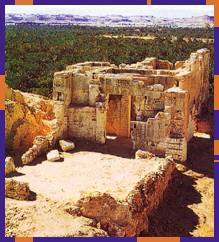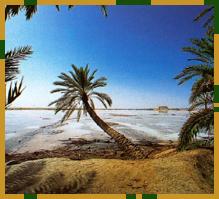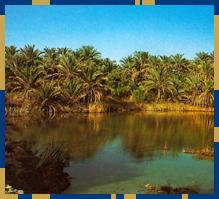Oases
| Siwa
- The Oracle of Amun |
Siwa
is the westernmost of the five major oases of Egypt and can
be reached by car from Baharia or from Marsa Matruh, on the
Mediterranean coast. In comparison with the other oases, the
most striking feature of the Siwan landscape is the presence
of several salt lakes, that diminish in size during the summer.
The salt also impregnates the soil, creating a big problem.
Mud bricks have been used for centuries to build entire village
fortresses, and are called "qasr" in Arabic, such as Shali
in Siwa, Qasr in Farafra, Qasr Dakhla in Dakhla and Qasr Kharga
in Kharga. In recent times, all of them have suffered mainly
from the rain rather than any human devastation. Shali, in
particular, has now been reduced to an impressive and dangerous
ruin due to the high content of salt in its mud bricks.
 |
To
the tourist, Siwa offers a wide range of beautiful traditional
products: baskets made of palm fronds and decorated with coloured
threads, embroidered fabrics and dresses, and the famous and
highly prized Siwan silver jewels, including elaborate necklaces
with pendants of various shapes, large incised bracelets and
rings, and heavy earrings with chains and bells - being too
heavy to be worn as earingss, they are left hanging on both
sides of the head suspended from a leather strip.
There
is a lot to see in Siwa, but probably one of the most famous
sites is Aghurmi, where the remains of the ancient Temple
of the Oracle of Amun are found. The temple was built during
the XXVI Dynasty of the Egyptian kings and the Oracle became
one of the most important of the Greek world. Two important
historical events are related to this place: the tragic expedition
of Cambyses' army (which will be mentioned in the paragraph
about Farafra) and the triumphal visit of Alexander the Great.
|

|
When
Alexander arrived in Egypt, after having founded Alexandria,
he headed to Siwa to consult the Oracle. After a dangerous
trip, he finally reached the oasis and his effort was rewarded
by the Oracle, who pronounced him a god.
After that, Alexander resumed his unstoppable conquest of
the Middle East but when he died, his body was apparently
returned to Egypt for burial. His tomb has never been found.
 |
Siwa
is surrounded by a number of minor oases. The small Qara Oasis,
where Alexander is said to have camped on his way to Siwa,
is very isolated and hosts only a small population. El-Harag,
Baharein, Sitra and Nuwemisa are today abandoned, but groups
of uninscribed rock-cut tombs suggest that the area was inhabited
probably during Roman times. El-Harag lies in vast and impressive
depression where the rocks have wonderful colours and the
landscape changes continuously, while the other three consist
of small lakes surrounded by vegetation and set among rock
outcrops and sand dunes. These oases are the ideal destination
for a tour on a 4x4 from Siwa. Just remember that "Nuwemisa"
means more or less "place of the mosquitoes" avoid it at
sunset or prepare yourself to be eaten alive.
 |
North-east
of Siwa there is the vast Qattara depression, over one hundred
metres below sea level, covered by salt. The region from Siwa
to the Mediterranean coast was the scene of more than one
battle during World War II, and the area of el-Alamein hosts
memorials and war cemetery for the thousands of British, German,
Italian, Greek and South African soldiers who died or disappeared
there.
(Corinna
Rossi)
|
|